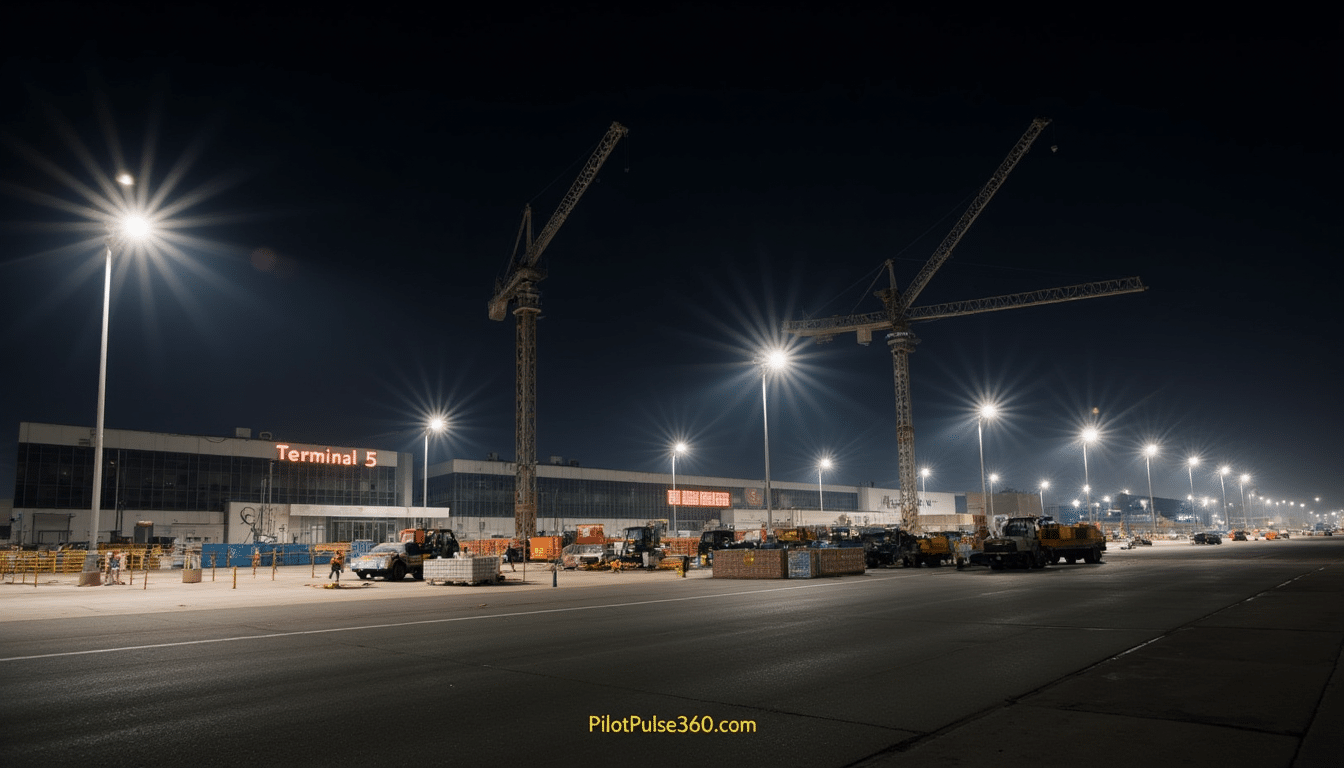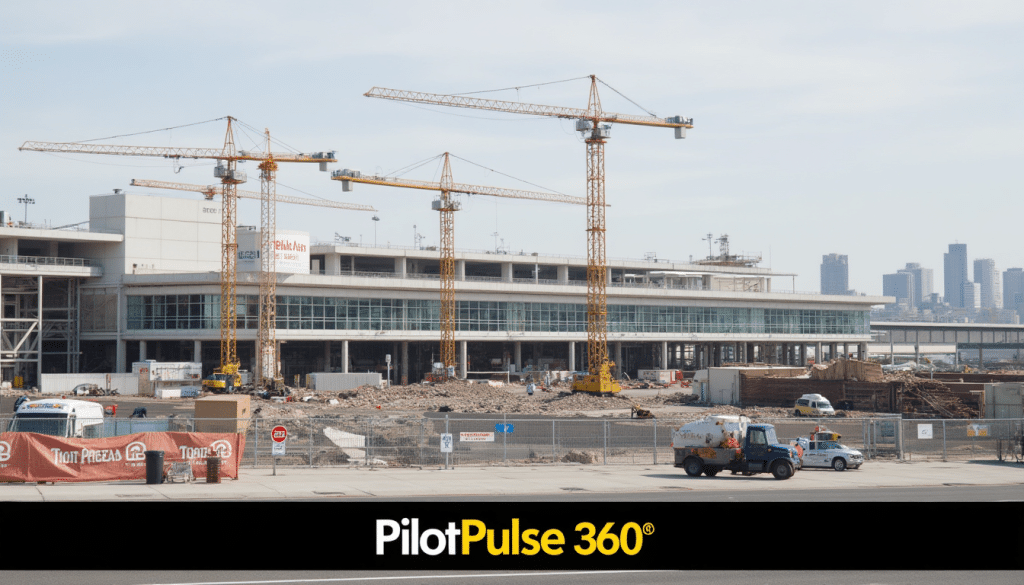Aviation News
LAX To Close Terminal 5 For Demolition & Complete Rebuild Ahead Of 2028 Olympics
Over the coming years, you’ll witness a dramatic transformation at Los Angeles International Airport as Terminal 5 closes on Tuesday, October 28 for complete demolition and reconstruction. Your travel plans through LAX will be affected as American Airlines, Spirit Airlines, and JetBlue relocate to different terminals during this phase of the $30 billion Capital Improvement Program. The new T5 represents a $200 million investment that will deliver you a world-class airport experience with state-of-the-art screening, enhanced amenities, and direct access to the new Automated People Mover train system, all designed to serve you better ahead of the 2028 Olympics.
Overview of LAX Modernization
Your journey through LAX is about to transform dramatically as part of the airport’s $30 billion Capital Improvement Program, the most ambitious infrastructure overhaul in the facility’s history. This comprehensive modernization touches nearly every corner of the airfield, from runways and taxiways to terminals and ground transportation systems. The Terminal 5 rebuild represents just one piece of this massive puzzle, accounting for over $200 million in investment. You’ll notice the addition of the Automated People Mover system, which will revolutionize how you navigate between terminals, parking structures, and the new consolidated rental car facility. These upgrades position LAX to handle increasing passenger volumes while delivering the world-class experience you’ll expect when the 2028 Olympics bring global attention to Los Angeles.
Scope of the Project
The T5 demolition and rebuild encompasses a complete teardown of the existing structure, leaving nothing of the old terminal behind. You’ll experience an entirely new facility featuring state-of-the-art ticketing systems, centralized security screening, and modern baggage claim areas. The project includes construction of the Terminal Vertical Core, which will serve as your primary access point to the Automated People Mover, along with an elevated walkway connecting you to the West Central Terminal Area APM station. Additionally, you’ll benefit from the $115-million T4 Connector, creating seamless access between T4, T5, and the Tom Bradley International Terminal through a unified terminal complex.
Timeline and Phased Closures
Terminal 5 officially closes on Tuesday, October 28, marking the beginning of your temporary adjustment period as airlines relocate operations. JetBlue and American Airlines will move to their new locations on closure day, while Spirit Airlines transitions to Terminal 2 on Wednesday, October 29. Your travel plans will need to account for these changes as the complete rebuild progresses toward the 2028 Olympics deadline.

The phased approach ensures you’ll continue experiencing minimal disruption throughout the construction period. While Terminal 5 undergoes its transformation, you’ll find that affected airlines have been strategically redistributed across existing terminals to maintain operational efficiency. The airport authority has coordinated these moves carefully to prevent bottlenecks during peak travel times. Your check-in and boarding processes will follow new pathways temporarily, but signage and staff will guide you through the transitions. Construction teams will work around the clock to accelerate the timeline, with major milestones scheduled to align with the Olympic preparations. You can expect periodic updates as each phase completes, bringing LAX closer to its vision of becoming one of the premier airport experiences in North America.
Details of Terminal 5 Demolition and Rebuild
Your journey through LAX will be transformed as Terminal 5 undergoes complete demolition starting October 28, marking one of the most extensive reconstruction projects in the airport’s history. The demolition phase will clear the existing structure down to its foundation, allowing construction teams to build an entirely new facility from the ground up. Hensel Phelps will lead the construction effort, coordinating with multiple design firms including San Francisco-based Gensler to create a cohesive vision. The rebuild timeline aligns strategically with the 2028 Olympics, ensuring LAX can accommodate the massive influx of international visitors expected during the games.
New Design and Features
You’ll notice the striking mid-century modern aesthetic with expansive glass facades that flood passenger areas with natural light throughout your terminal experience. The architectural design prioritizes both form and function, featuring the innovative Terminal Vertical Core that seamlessly integrates first and second-floor access with direct connections to the Automated People Mover. An elevated walkway will connect you directly from T5 to the West Central Terminal Area APM station, eliminating the need for shuttle buses. The design aims for LEED Silver certification, incorporating sustainable building practices and energy-efficient systems throughout the 300,000-square-foot structure.
Planned Amenities and Services
Your travel experience will be elevated with 16 state-of-the-art security lanes designed to dramatically reduce wait times during peak hours. The terminal will feature centralized ticketing and baggage claim areas equipped with cutting-edge technology, while world-class dining and retail options will provide you with premium shopping and culinary experiences. Throughout the gate areas, you’ll find abundant power access points to keep your devices charged, complemented by modern seating arrangements and completely redesigned restrooms with contemporary finishes.
Beyond the basics, you’ll benefit from enhanced passenger services that reflect LAX’s commitment to world-class airport operations. The 30 gates across the unified T4/T5 structure will accommodate both domestic and international flights, with two specially designed gates offering flexible configurations for various aircraft types. Your baggage handling will be streamlined through the south matrix interline baggage transfer facility, making connections smoother than ever. The modernized Customs and Border Protection Federal Inspection Station will expedite your international arrivals, while the four-lane passenger security screening checkpoint in the T4 Connector provides additional capacity during busy travel periods. You’ll also enjoy the new public plaza on the upper level, offering outdoor seating where you can relax before your flight while taking in views of the airfield operations.
Impact on Airlines and Passengers: Delta Airlines terminal closure LAX
Your travel plans through LAX will see significant changes as three major airlines relocate to different terminals during the T5 closure period. If you’re flying with American Airlines, JetBlue, or Spirit Airlines, you’ll need to familiarize yourself with new departure and arrival locations starting October 28. The transition affects thousands of daily passengers, but airport officials have coordinated the moves to minimize disruption. JetBlue will operate from Terminal 1, American Airlines shifts to Terminal 4, and Spirit Airlines moves to Terminal 2 beginning October 29. You should arrive earlier than usual for your first few trips to account for navigating unfamiliar terminal layouts.
Airline Relocations
The staggered relocation schedule ensures your airline has time to establish operations in its temporary home. JetBlue and American Airlines will complete their moves on October 28, while Spirit Airlines follows one day later on October 29. Your airline will send notifications about the terminal changes, but you should verify your departure terminal when checking in. Ground transportation, parking, and rideshare pickup locations will differ from what you’re accustomed to at T5. These relocations will remain in effect until the new T4/T5 complex opens ahead of the 2028 Olympics.
Passenger Experience Enhancements
Once construction completes, you’ll enjoy a dramatically improved airport experience with 16 security lanes designed to process travelers faster and more efficiently. The new 300,000-square-foot unified T4/T5 building with 30 gates will feature mid-century modern design with abundant natural light streaming through glass facades. Your journey through the terminal will be streamlined with centralized ticketing, state-of-the-art screening equipment, and modernized baggage claim areas.
You’ll benefit from direct access to the Automated People Mover, eliminating long walks or crowded bus rides between terminals. The new Terminal Vertical Core connects you seamlessly between floors and the APM station via centralized escalators and elevators. Inside the gates, you’ll find plentiful charging stations at every seating area, world-class dining options, and premium retail shopping. The $115-million T4 Connector provides efficient access to the Tom Bradley International Terminal, making international connections significantly easier. Your comfort matters too—all passenger spaces and restrooms will feature modern finishes and amenities that reflect a truly world-class airport experience worthy of the 2028 Olympics.
Environmental and Efficiency Goals
You’ll find that the T4/T5 rebuild prioritizes environmental responsibility alongside operational excellence. The project targets LEED Silver certification from the US Green Building Council for the Terminal Vertical Core and new T4 sections, demonstrating LAX’s commitment to sustainable aviation infrastructure. The 104,170 square foot T4 Connector already holds CAL Green Certification, setting a benchmark for eco-conscious airport construction. Your travel experience will benefit from energy-efficient systems, reduced carbon footprint operations, and design elements that maximize natural lighting to minimize electricity consumption throughout the terminals.
Sustainability Initiatives
Beyond certification goals, you’ll experience terminals built with sustainable materials and advanced environmental systems. The mid-century modern glass facade isn’t just aesthetically pleasing—it strategically reduces artificial lighting needs during daylight hours, cutting energy consumption significantly. State-of-the-art HVAC and water management systems will operate throughout both terminals, while the integration with the Automated People Mover reduces ground transportation emissions by encouraging public transit use over individual vehicles, directly supporting California’s ambitious climate goals ahead of the 2028 Olympics.
Capacity Improvements
Your wait times will decrease dramatically thanks to strategic capacity enhancements throughout the rebuild. The new unified T4/T5 complex features 16 security lanes compared to the previous configuration, while the redesigned ticket and check-in areas streamline passenger processing.
The 30 gates spanning over 300,000 square feet will accommodate increased passenger volumes without the crowding you may have experienced in the old Terminal 5. Your connection between terminals becomes seamless with the four-story T4 Connector providing direct access to the Tom Bradley International Terminal, eliminating the need for shuttle buses or lengthy walks. The centralized baggage systems, including the south matrix interline baggage transfer facility, ensure your luggage moves efficiently between airlines and gates. With APM access directly integrated into the Terminal Vertical Core, you’ll navigate between terminals and ground transportation faster than ever, addressing the congestion issues that have plagued LAX for decades.
Key Contractors and Partnerships: Terminal 5 redevelopment LAX
You’ll find that this massive undertaking relies on collaboration between some of the nation’s most respected construction and design firms. Hensel Phelps leads the general contracting effort for the T4/T5 project, bringing their extensive airport specialization to bear on this $200 million rebuild. Turner Construction handles the Bradley West Terminal 4 Connector separately, demonstrating the scale of coordination required. Meanwhile, San Francisco-based Gensler designs the Terminal Vertical Core, while Texas-based PGAL serves as the design partner for T4, and Corgan collaborates on the connector project. These partnerships ensure your future travel experience meets world-class standards before the 2028 Olympics arrive.
General Contractors
Hensel Phelps stands as one of California’s premier general contractors, with proven expertise across airports, hospitals, hotels, and government facilities statewide. Your terminal reconstruction benefits from their track record on both small-scale improvements and mega-projects throughout the region. Turner Construction complements this effort by managing the four-story, 75,000-square-foot Bradley West Terminal 4 Connector, which will provide you with seamless access between terminals. Both firms bring nationwide construction experience to ensure your LAX experience transforms on schedule.
Design Firms
Gensler leads the architectural vision for the Terminal Vertical Core, bringing their San Francisco-based expertise to create the centralized escalator and elevator hub that will connect you to the Automated People Mover. Texas-based PGAL partners on T4’s overall design, while Corgan collaborates on the connector’s aesthetic.

These design firms prioritize your comfort through mid-century modern glass facades that maximize natural lighting and create an open, welcoming atmosphere. You’ll notice Gensler’s attention to passenger flow in the vertical core’s integration of first-floor, second-floor, and APM access points. The design teams are working toward LEED Silver certification from the US Green Building Council, meaning your travel through these spaces will occur in an environmentally responsible facility. PGAL and Corgan’s collaboration ensures the new public plaza on the connector’s upper level offers you outdoor seating options, while maintaining architectural consistency across the entire T4/T5 complex.
Future Prospects for LAX terminal improvements 2025–2028
Beyond the Terminal 5 demolition and rebuild, you’ll witness LAX transform into one of the world’s premier aviation hubs as part of the $30 billion Capital Improvement Program. The airport’s modernization extends far beyond individual terminals, encompassing everything from airfield infrastructure to ground transportation systems. Your experience at LAX will fundamentally change as the Automated People Mover connects all terminals, rental car facilities, and the Metro system by the 2028 Olympics. This comprehensive overhaul positions LAX to handle projected passenger volumes exceeding 100 million annually while maintaining world-class service standards.
Long-term Vision
You’ll see LAX evolve into a fully integrated transportation hub where seamless connections between air, rail, and ground transport become the standard. The airport’s master plan envisions eliminating vehicular congestion through the APM system while creating a unified terminal complex that rivals the best airports globally. Your journey through LAX will feature consistent mid-century modern design elements, sustainable building practices targeting LEED certification, and technology-driven passenger processing that reduces wait times across ticketing, security, and baggage claim areas throughout every terminal.
Anticipated Outcomes
When construction completes, you’ll benefit from dramatically reduced congestion and wait times across all airport operations. The unified T4/T5 complex with 30 gates and 16 security lanes will process passengers more efficiently than ever before.
Your overall airport experience will improve measurably through enhanced amenities, expanded dining and retail options, and direct APM access from every terminal. The modernized infrastructure will support increased flight capacity while maintaining on-time performance, particularly during the 2028 Olympics when LAX expects unprecedented passenger volumes. The environmental benefits include reduced vehicle emissions from the APM system and LEED Silver-certified buildings, making your travel through LAX more sustainable while the airport achieves its operational efficiency goals.
To wrap up LAX renovation plans 2028
Conclusively, you’ll witness a transformative moment at LAX as Terminal 5 undergoes complete demolition and reconstruction ahead of the 2028 Olympics. This $200 million project, part of LAX’s $30 billion modernization program, will deliver enhanced passenger experiences through state-of-the-art facilities, streamlined security processes, and seamless connectivity via the Automated People Mover. While you may experience temporary adjustments with airline relocations, the resulting 300,000-square-foot T4/T5 complex will provide you with 30 gates, modern amenities, and significantly reduced congestion. Your future travels through LAX will benefit from this ambitious infrastructure investment designed to create a world-class airport experience.
Frequently Asked Questions
Why is Terminal 5 at LAX being closed and rebuilt?
Terminal 5 is being closed for complete demolition and a full rebuild in preparation for the 2028 Summer Olympics. The upgrade is part of a broader modernisation of LAX’s terminals.
The $14BN Race to Transform LAX for the 2028 Olympics
When will Terminal 5 at LAX close for demolition?
The closure begins in October 2025. Airlines that currently operate at Terminal 5 (such as American Airlines, JetBlue Airways, and Spirit Airlines) are already relocating to other terminals ahead of the demolition.
What airlines are affected by the Terminal 5 rebuild at LAX?
The airlines affected include American Airlines, JetBlue and Spirit. Their operations from Terminal 5 will move to other terminals during the closure and rebuilding phase.
When is the rebuilt Terminal 5 expected to reopen?
The rebuilt Terminal 5 is expected to reopen ahead of the 2028 Summer Olympics, with full completion targeted for 2028.
What improvements or changes can passengers expect from the rebuild?
Passengers can expect modernised facilities, enhanced passenger flows, and improved connectivity to other terminals and transport links. The rebuild will replace mechanical, electrical and plumbing systems, upgrade ticketing and security screening, and improve the overall passenger experience.
Will the number of gates at Terminal 5 change after the rebuild?
No. The number of gates at Terminal 5 is expected to remain roughly the same, but the facilities will be significantly upgraded.

